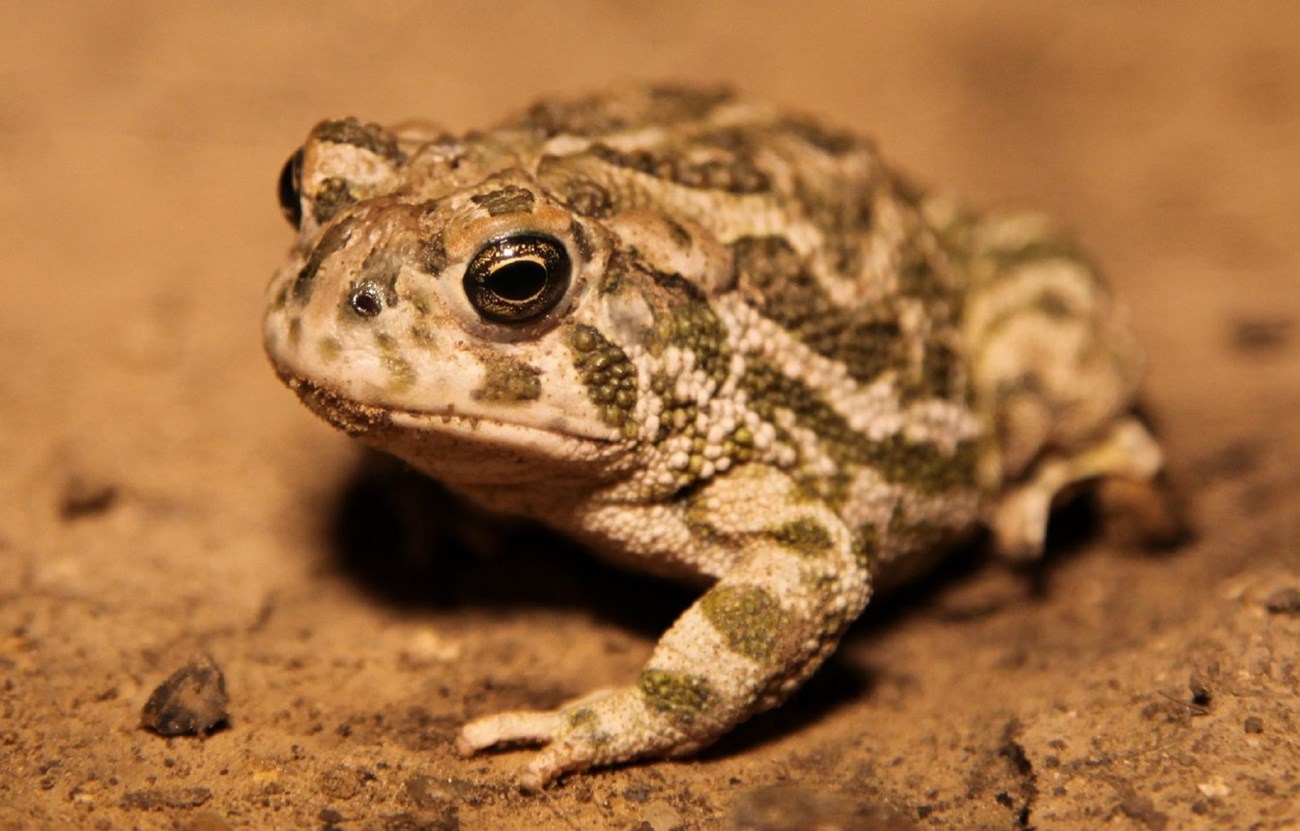
© Texan Wild Little Bighorn Battlefield National Monument is home to six amphibian species. The word "amphibian" is derived from the Greek word amphibios, which means "a being with a double life". Amphibians begin life in freshwater ecosystems such as lakes and streams. The larvae have gills and a tail when they hatch from eggs laid in water. Young amphibians usually change their body shape, diet, and lifestyle to live on land as adults –a process called metamorphosis. The Boreal Chorus Frog and the Northern Leopard Frog, the two frog species residing at Little Bighorn Battlefield, provide good examples of metamorphosis. They begin their lives as tadpoles, legless aquatic creatures, and only inhabit the freshwater ecosystems they were born into. Within months, the frogs develop lungs, legs, and a different mouth while losing their tail. This allows them to live most of their adult lives on land, exemplifying their double life. Amphibians appear very adaptable due to their ability to live in water and on land, but they are actually very sensitive to environmental factors. Amphibians are ectotherms like their 'cold-blooded' reptile relatives. An ectotherm is an animal that depends on external energy sources to maintain their body temperature. Amphibians often bask in the sun to raise their body temperature. When it's too cold to bask, they enter a hibernation-like state known as brumation. This is how amphibians are able to survive in almost any environment that has a freshwater ecosystem. Adult amphibians need to have regular contact with water to keep their skin moist or they need to produce slimy secretions to protect their skin. Most amphibians have thin, permeable skin that allows water and oxygen to easily pass through. This permits amphibians to breathe and drink water through their skin, which is critical because amphibians cannot drink through their mouths. In fact, most amphibians experience severe dehydration if they do not frequently visit a freshwater source. The six amphibian species at Little Bighorn Battlefield National Monument utilize the Little Bighorn River and the adjacent grassland environment. Those species are listed below.
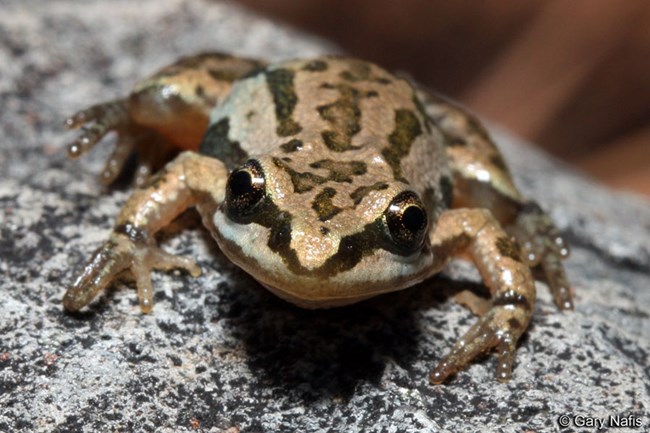
Common Name: Boreal Chorus Frog Scientific Name:Pseudacris maculata Identification: Adult base color is highly variable their back can be green, brown, gray, or a reddish tone. Usually three to five dark longitudinal stripes, sometimes broken into spots, are on the head and back, and a dark line extends from the snout through the eye to the groin. Adults have tiny toe pads. Adult body length is 0.75 to 1.5 inches (1.9 to 3.8 cm). Tadpoles are brown or bronze with eyes located on the sides of their head. Habitat: In Eastern Montana, Boreal Chorus Frogs breed in temporary ponds and small lakes that are surrounded by prairie, or occasionally open forest habitats. They are generally found in damp grassy or marshy areas, or damp forests near a freshwater body when not breeding. Individuals may undergo seasonal migrations of 273 yards (250 m), but do not travel further than 765 yards (700 m) from their natal sites. Behavior: Little is known about the Boreal Chorus Frog's behavior. They are usually only found in water during the spring breeding period. During this period, they call frequently at night and sporadically during the day. After breeding, they move to adjacent upland and are rarely seen. Adult and juvenile Boreal Chorus Frogs feed on a variety of arthropods, their own shed skins, and vegetation. Tadpoles feed on a variety of algae. More Information: http://fieldguide.mt.gov/speciesDetail.aspx?elcode=AAABC05130 
Common Name: Northern Leopard Frog Scientific Name:Lithobates pipiens Other Names: Rana pipiens Identification: Adults and juveniles have a green, brown, or rarely blueish base color on their backs. Their backs are covered with large, dark oval spots that are surrounded by a lighter boarder. The abdomen ranges from a white to cream color with some pinkish patches on the feet. The skin is smooth, the dorsolateral folds face outwards, and the hind toes have extensive webbing. Tadpoles have dark brown, olive, or gray backs with light gold and black flecking on their sides. Their abdomen is silvery-white or transparent. Habitat: Northern Leopard Frogs occupy a variety of wetland habitats to meet annual requirements for all life stages they reside in ponds, reservoirs, lakes, creeks, pools in intermittent streams, warm water springs, potholes, and marshes. There is no evidence that this species occupies high elevation wetlands in Montana. During the summer, adults and juveniles feed in open or semi-open wet meadows and fields with shorter vegetation. They prefer terrestrial environments that are adjacent to water bodies because they seek cover underwater. During the winter, they become inactive at the bottom of deep streams, ponds, or springs where water remains in its liquid form and is well oxygenated until surface ice melts. Behavior: Northern Leopard Frogs are active during the day and night. In Montana, the active period for adults is from mid-March to early October. However, the start of spring activity depends on when ice melts. Males float on the surface of the water in shallow, quiet areas to begin breeding. They vocalize on sunny days when the water temperature is between 57 and 73 degrees Fahrenheit (14 and 23 degrees Celsius). The male breeding call is a snoring sound lasting two to three seconds followed by a series of two to three stuttering croaks or chuckles. In favorable habitat, more than 25 males may gather in a 215 square foot (20 square meter) area. Females begin laying eggs a few days after calling begins. Adults feed on invertebrates and other amphibian larvae. Tadpoles eat algae, plant matter, and small invertebrates. More Information: http://fieldguide.mt.gov/speciesDetail.aspx?elcode=AAABH01170 1 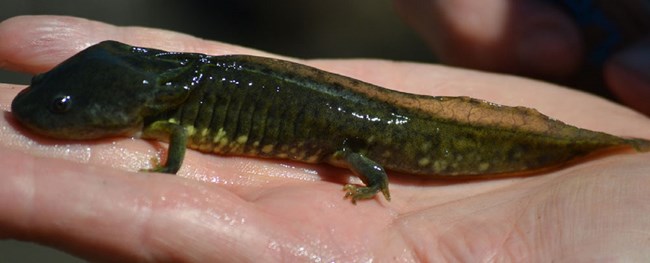
Common Name: Western Tiger Salamander Scientific Name: Ambystoma mavortium Other Names: Tiger Salamander, Barred Tiger Salamander, Ambystoma tigrinum Identification: Adults vary in color pattern, but their background color is usually dark with yellow, tan, or green patches on top. Adults are large and heavy-bodied with a body length of three to six inches (7.6 to 15.25 cm). Larvae are pale green or brown with a body length that ranges from 0.75 to four inches (1.9 to 10 cm). They have three large pairs of gills, and a dorsal fin that extends from their axillary region to their tail fin. Larvae also have vomerine teeth in a U-shaped pattern, which stops prey from fleeing. Habitat: Western Tiger Salamanders in Montana are primarily found in prairies or agricultural fields. Adults migrate to ponds soon after snowmelt they breed in calm freshwater bodies where fish are not present. In high elevations, Western Tiger Salamanders tend to select the warmest water in ponds, moving between shallow water during the day and deep water at night. After breeding, adults remain in the ponds or move to burrows in upland areas. Behavior: Adults may migrate several hundred yards between terrestrial burrows and breeding habitats. Migration usually occurs during nighttime precipitation events when temperatures are above 32 degrees Fahrenheit (0 degrees Celsius). During the breeding period, eggs are attached to submerged objects at shallow depths. Larvae may enter metamorphosis after their first summer if the growing season is long enough, but often remain larvae for a second or third summer at high elevations. Larvae can become sexually mature and reproduce without undergoing metamorphosis. In water, larvae and adults feed on a variety of aquatic and terrestrial invertebrates and some amphibian larvae. On land, adults feed on invertebrates and small mammals. More Information: http://fieldguide.mt.gov/speciesDetail.aspx?elcode=AAAAA01142 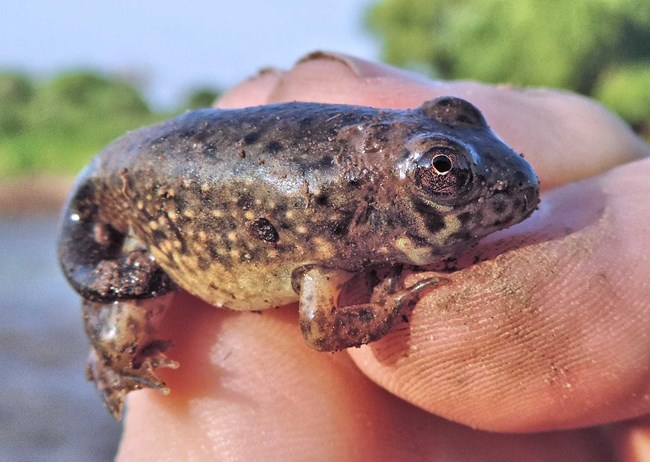
Common Name: Plains Spadefoot Toad Scientific Name: Spea bombifrons Other Names: Plains Spadefoot Identification: Adults have a gray or brown base color with darker spots on the back and a white abdomen. The back may also have small tubercles with yellow or orange tips. Some individuals have distinct longitudinal streaks. Adults have a hard, round lump –a boss –between their eyes, and their pupils vertically elongate in bright light. Each hind foot has a hard, dark wedge-shaped spade. Tadpole base color varies from brown to green and white on the back. They may also be mottled gray or dull olive-yellow and have a bluish iridescence. The abdomen is an iridescent gold color. The dorsal fin is clear, but can have sparse yellow flecking. Habitat: Plains Spadefoot Toads reside in areas with soft sandy and gravelly soils near permanent or temporary water bodies. They inhabit native grassland and shrub lands as well as areas with non-native vegetation. Adults are largely inactive in rodent or self-excavated burrows, and only enter water to breed. Adults have been reported in water up to 11.8 inches (30 cm) deep following heavy rains. Tadpoles and toadlets have been reported in stock ponds and small temporary reservoirs in sagebrush-grassland habitats. Behavior: Little is known about the Plains Spadefoot Toad's behavior. The male breeding call is a brief snore. Adults feed on a variety of insects at night. Tadpoles have two common morphologies: 1) omnivores that feed on phytoplankton and detritus, and 2) carnivores that feed on fairy shrimp, invertebrates, and amphibian larvae. Juveniles and adults commonly disperse at least 1.4 miles (2.25 km) from ponds after the breeding period. More Information: http://fieldguide.mt.gov/speciesDetail.aspx?elcode=AAABF02010 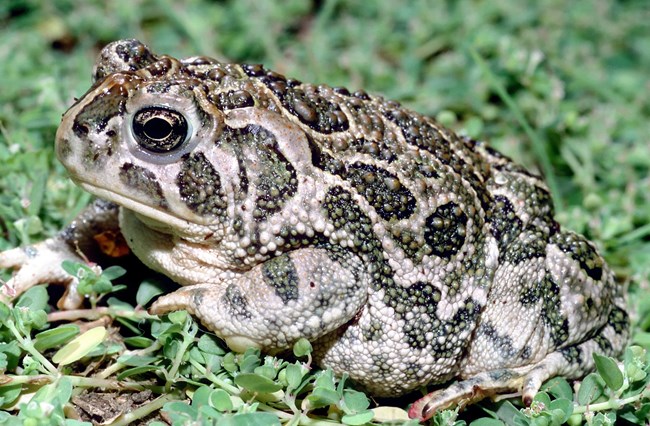
Common Name: Great Plains Toad Scientific Name: Anaxyrus cognatus Other Names: Bufo cognatus Identification: Theadult Great Plains Toad's skin is covered with small warts. The back has a somewhat symmetrical pattern of large dark patches with lighter edges. Cranial crests are prominently positioned behind a hard lump –a boss –on top of the snout. The undersides of the hind feet often have a sharp-edged tubercle and a smaller dark-tipped tubercle. Females can reach 4.5 inches long (11.4 cm), while males are usually less than 3.7 inches (9.5 cm). The vocal sac extends beyond the front of the face when inflated. Juveniles have reddish warts. Tadpoles are black on the dorsum at first with light or gold flecking, but become paler and mottled brown large, paired patches appear on the dorsum before metamorphosis is complete. Habitat: Little is known about the Great Plains Toad's habitat preferences in Montana. They are commonly found in upland grasslands with hard packed soils, but are occasionally found in floodplain habitats. Breeding is the only time adults enter water. Breeding takes place in clear, shallow temporary pools directly after heavy late spring and summer rains when temperatures are above 54 degrees Fahrenheit (12 degrees Celsius). Behavior: Adults are dormant in rodent or self-excavated burrows for most of the year, but emerge during warmer and moister periods to feed on terrestrial invertebrates. Tadpoles are herbivores and detritivores. The species has been known to migrate several hundred yards between breeding pools and non-breeding terrestrial habitats. The breeding call is a long continuous trill or pulsating ringing sound. More Information: http://fieldguide.mt.gov/speciesDetail.aspx?elcode=AAABB01050 
Common Name: Woodhouse's Toad Scientific Name: Anaxyrus woodhousii Other Names: Bufo woodhousii Identification: Adults have gray, brown, or olive green skin covered with paler spots and small warts. They have two black 'spades' on each hind foot. A prominent white or pale yellow line runs down the center of the adults back. Juvenile toads lack this marking and have reddish brown warts. Adult and juvenile toads have parallel cranial crests on their snout and behind the eyes in the shape of an "L". Tadpoles have a black or dark brown body with gold flecking on their sides and gray to white flecking on their abdomen. Habitat: Adults stay close to freshwater sources although they live on land, and are known to disperse up to one and a half miles (2.4 kilometers) from their natal breeding sites. Adults are commonly found in moist grass areas with loose sandy soils –usually floodplains and irrigated agricultural areas. In non-forested Eastern Montana, they breed in permanent lakes, ponds, reservoirs, and slow streams that have shallow areas with mud bottoms. However, some Woodhouse's Toad breeding records are from transition vegetation in ponderosa pine ecosystems and savannah forests. Behavior: Breeding takes place after spring and summer rains when temperatures are at least 50 degrees Fahrenheit (10 degrees Celsius), but breeding groups known as "choruses" may form in dry weather. The largest choruses form at or above 60 degrees Fahrenheit (16 degrees Celsius). Egg strings are wrapped around vegetation in shallow areas of lakes, reservoirs, floodplain pools, and other permanent water bodies. Adults are known to live up to 19 years. More Information:http://fieldguide.mt.gov/speciesDetail.aspx?elcode=aaabb01180 |
Last updated: April 23, 2025
